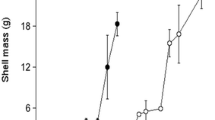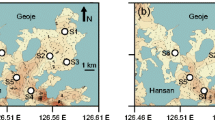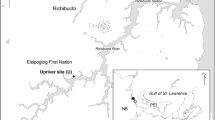Abstract
The present study examines the influence that environmental variables exerted on changes in condition index (CI), shell height (SH—dorsal-ventral axis) and soft tissue mass increments (STM) of the winged oyster Pteria colymbus in suspended culture during periods of upwelling (December to April) and non-upwelling (August to November) in the Cariaco Gulf, northeastern Venezuela. Environmental variables recorded between April 2012 and May 2013 included seston, water transparency, temperature, dissolved oxygen, chlorophyll a (Chl a) and the upwelling index (UI). Individuals were cultivated in lantern nets with an overall density of 56 individuals/0.123 m2. From three randomly chosen baskets, five individuals were sampled each month and changes in CI, STM and SH were related to the environmental variables using Spearman correlation and PCA. Results show that during upwelling, both Chl a and UI presented a positive and significant relationship with the oyster condition and growth parameters. During non-upwelling (low UI), this relationship was inverse, demonstrating the important influence of upwelling and non-upwelling periods on the ecophysiology of the species. Furthermore, it was shown that the non-upwelling, characterized by high temperatures and low food availability, is a critical period for P. colymbus, judging by a decrease in growth and survival rate. Nonetheless, this species reached 50 mm in 5 months, a size considered as commercially viable, suggesting that the study area is favourable to the cultivation of the winged oyster despite a dramatic decrease in upwelling intensity in the last decade.





Similar content being viewed by others
References
Arellano-Martínez M, Ceballos-Vázquez B, Villalejo-Fuerte M, García-Domínguez F, Elorduy-Garay J, Esliman-Salgado A, Racotta I (2004) Reproduction of the lion’s paw scallop Nodipecten subnodosus Sowerby, 1835 (Bivalvia: Pectinidae) from Laguna Ojo de Liebre, B.C.S., México. J Shellfish Res 23:723–729
Astor Y, Muller-Karger F, Scranton MI (2003) Seasonal and interannual variation in the hydrography of the Cariaco Basin: implications for basin ventilation. Cont Shelf Res 23:125–144
Bayne BL (1976) Aspects of reproduction in bivalve mollusks. In: Wiley M (ed) Estuarine processes, vol 1. Academic, New York, pp 432–448
Beninger GP, Lucas A (1984) Seasonal variations in condition, reproductive activity and gross biochemical composition of two species of adult clam reared in a common habitat: Tapes decussatus L. (Jeffreys) and Tapes philippinarum (Adams and Reeve). J Exp Mar Biol Ecol 79:19–37
Bowden KF (1983) Physical oceanography of coastal waters. Ellis Horwood, Chichester, p 302
Chatfield C, Collins A (1980) Introduction to multivariate analysis. Chapman and Hall, London
Clarke K, Warwick R (2001) Change in marine communities: an approach to statistical analysis and interpretation. PRIMER-E Ltd., Plymouth, p 82
Díaz AH, Buckle-Ramírez LF (1996) Ciclo gonádico de Pteria sterna (Gould, 1851) (Mollusca, Bivalvia) en Baja California, México. Cienc Mar 22:495–509
Díaz JM, Puyana M (1994) Moluscos del Caribe colombiano. Un catálogo ilustrado. Colcienciasfundación Natura-Invemar. Presencia, Bogotá, p 291
Dupuy C, Vaquer A, Lam-Höai T, Rougier C, Mazouni N, Lautierm J, Collos Y, Gall SL (2000) Feeding rate of the oyster Crassostrea gigas in a natural planktonic community of the Mediterranean Thau Lagoon. Mar Ecol Prog Ser 205:171–184
Figueiras FG, Labarta U, Reiriz MJF (2002) Coastal upwelling, primary production and mussel growth in the Rias Baixas of Galicia. Hydrobiologia 484:121–131
Freites L, Lodeiros C, Himmelman J (1999) Impact of recruiting gastropods and decapods predators on the scallop Euvola ziczac (L.), in suspended culture. J Exp Mar Biol Ecol 244:295–303
Freites L, Lodeiros C, Narváez N, Estrella G, Babarro JMF (2003) Growth and survival of the scallop Lyropecten (=Nodipecten) nodosus (L., 1758) in suspended culture in the Cariaco Gulf (Venezuela), during a non-upwelling period. Aquac Res 34:709–718
Freites L, Montero L, Arrieche D, Babarro P, Saucedo P, Cordova C, García N (2010a) Influence of the environmental factors on the reproductive cycle of the tropical bivalve Anadara notabilis (Röding, 1798). J Shellfish Res 29:69–75
Freites L, Cordova C, Arrieche D, Montero L, García N, Himmelman JH (2010b) Reproductive cycle of the penshell Atrina seminuda (Mollusca: Bivalvia) in tropical waters. Bull Mar Sci 86:785–801
Gómez-Robles E, Saucedo P (2009) Evaluation of quality indices of the gonad and somatic tissues involved in reproduction of the pearl oyster Pinctada mazatlanica with histochemistry and digital image analysis. J Shellfish Res 28(2):329–335
Hawkins AJS, Bayne BL, Mantoura RFC, Llewellyn CA, Navarro E (1986) Chlorophyll degradation and absorption throughout the digestive system of the blue mussel Mytilus edulis L. J Exp Mar Biol Ecol 96:213–223
Heffernan PB, Walker RL, Carr JL (1989) Gametogenic cycles of three bivalves in Wassaw Sound, Georgia: I. Mercenaria mercenaria, (Linnaeus, 1758). J Shellfish Res 8:51–60
Herrera L, Febres-Ortega G (1975) Kinematics of the wind-generated velocity field in the surface waters off eastern Venezuela, Caribbean Sea. Bol Inst Oceanogr Univ Oriente 14(2):165–186
Kang C, Park M, Lee P, Choi W, Lee W (2000) Seasonal variations in condition, reproductive activity, and biochemical composition of the Pacific oyster, Crassostrea gigas (Thunberg), in suspended culture in two coastal bays of Korea. J Shellfish Res 19:771–778
Kang CK, Lee YW, Choy EJ, Shin JK, Seo IS, Hong JS (2006) Microphytobenthos seasonality determines growth and reproduction in intertidal bivalves. Mar Ecol Prog Ser 315:113–127
Kowalewski M, Simões MG, Carroll M, Rodland DL (2002) Abundant brachiopods on a tropical upwelling-influenced shelf (Southeast Brazilian Bight, South Atlantic). PALAIOS 17:277–286
Lavin A, Díaz del Rio G, Cabanas JM, Cabanas G (1991) Afloramiento en el noroeste de la Península Ibérica. Índices de afloramiento para el punto 43º N 11º W periodo 1990–1999. Informes técnicos del Instituto Español de Oceanografıa 91:33
Lodeiros C, Freites L 2008 Estado actual y perspectivas del cultivo de moluscos bivalvos en Venezuela. In: Lovatelli A, Farías A, Uriarte I (eds) Estado actual del cultivo y manejo de moluscos bivalvos y su proyección futura: factores que afectan su sustentabilidad en América Latina. Taller Técnico Regional de la FAO. 20–24 de agosto de 2007, Puerto Montt, Chile. FAO Actas de Pesca y Acuicultura. No. 12. Roma, FAO, p 135–150
Lodeiros C, Himmelman J (1994) Relationships among environmental conditions and growth of the tropical scallop Euvola (Pecten) ziczac (L.) in suspended in the culture in the Gulf of Cariaco, Venezuela. Aquaculture 119:345–358
Lodeiros C, Himmelman J (1999) Reproductive cycle of the bivalve Lima scabra (Pteroidea: Limidae) and its association with environmental conditions. Rev Biol Trop 47:411–418
Lodeiros C, Rengel JJ, Himmelman JH (1999a) Growth of Pteria colymbus (Röding, 1798) in the Golfo de Cariaco, Venezuela. J Shellfish Res 18:155–158
Lodeiros C, Marín B, Prieto A (1999b) Catálogo de moluscos marinos de las costas nororientales de Venezuela. Clase Bivalvia. Edición APUDONS, Cumaná, p 109
Lodeiros C, Pico D, Prieto A, Narváez N, Guerra A (2002) Growth and survival of the pearl oyster Pinctada imbricata (Röding 1758) in suspended and bottom culture in the Golfo de Cariaco, Venezuela. Aquacult Inter 10:327–339
Lodeiros C, Freites L, Graziani C, Alió J (2011) Cultivation of bivalve molluscs in Venezuela: diversity, potential and infrastructure for seed production. In: Lovatelli A, Sarkis S (eds) A regional shellfish hatchery for the Wider Caribbean: assessing its feasibility and sustainability. FAO Regional Technical Workshop. 18–21 October 2010, Kingston, Jamaica. FAO Fisheries and Aquaculture Proceedings. No. 19. Rome, FAO, pp 161–170
Luna-González A, Cáceres-Martínez C, Zuñiga-Pacheco C, López-López S, Ceballos-Vásquez B (2000) Reproductive cycle of Argopecten ventricosus (Sowerby II. 1842). (Bivalvia-Pectinidae) in the Rada of Puerto Pichilingue, BCS, Mexico and its relation to temperature, salinity and quality of food. J Shellfish Res 19:107–112
Ma H, Grassle JP, Chant RJ (2006) Vertical distribution of bivalve larvae along a cross-shelf transect during summer upwelling and downwelling. Mar Biol 149:1123–1138
Malavé C, Freites L, Lodeiros C, Mendoza J, Troccoli L, Dale AW (2012) Annual recruitment, predation rates and biocontrol of Linatella caudata (Mollusca: Gastropoda) in suspended enclosure culture of the pearl oyster Pinctada imbricata. Aquaculture 354-355:75–83
Marta-Almeida M, Dubert J, Peliz A, Queiroga H (2006) Influence of vertical migration pattern on retention of crab larvae in the shelf in a seasonal upwelling system. Mar Ecol Prog Ser 307:1–19
Menge BA, Daley BA, Wheeler PA, Dahlhoff E, Sanford E, Straub PT (1997a) Benthic-pelagic links and rocky intertidal communities: bottom-up effects on top-down control? Proc Natl Acad Sci U S A 94:14530–14535
Menge BA, Daley BA, Wheeler PA, Straub PT (1997b) Rocky intertidal oceanography: an association between community structure and nearshore phytoplankton concentration. Limnol Oceanogr 42:57–66
Miguez BM, Farina-Busto L, Figueiras FG, Perez FF (2001) Succession of phytoplankton assemblages in relation to estuarine hydrodynamics in the Ria de Vigo: a box model approach. Sci Mar 65:65–76
Muller-Karger FE, Aparicio-Castro R (1994) Mesoscale processes affecting phytoplankton abundance in the Southern Caribbean Sea. Cont Shelf Res 14(2/3):199–221
Muller-Karger F, Taylor GT, Astor Y, Thunnell RC, Scranton MI, Varela R, Troccoli L, Lorenzoni L, Montes E, Fanning KA, Benitez-Nelson C (2013) The CARIACO Basin ocean time-series. LOICZ Inprint 1:3–17
O’Connor WA, Lawler NF, Heasman MP (2003) Trial farming the akoya pearl oyster, Pinctada imbricata, in Port Stephens, NSW. NSW Fisheries Final Report Series 42:170
Okuda T, Benítez-Álvarez J, Bonilla J, Cedeño G (1978) Características hidrográficas del Golfo de Cariaco, Venezuela. Bol Inst Ocenogr Vzla Univ Oriente 17:69–88
Pernet F, Malet N, Pastoureaud A, Vaguer A, Quere C, Dubroca L (2012) Marine diatoms sustain growth of bivalves in a Mediterranean lagoon. J Sea Res 68:20–32
Phillips NE (2005) Growth of filter-feeding benthic invertebrates from a region with variable upwelling intensity. Mar Ecol Progr Ser 295:79–89
R Core Team (2015) R: a language and environment for statistical computing. R Foundation for Statistical Computing, Vienna URL http://www.R-project.org/
Racotta I, Ramírez JL, Avila S, Ibarra A (1998) Biochemical composition of gonad and muscle in the catarina scallop Argopecten ventricosus, after reproductive conditioning under feeding systems. Aquaculture 163:111–122
Racotta I, Ramírez J, Ibarra A, Rodríguez-Jaramillo C, Carreño D, Palacios E (2003) Growth and gametogenesis in the lion’s paw scallop Nodipecten (Lyropecten) subnodosus. Aquaculture 217:335–349
Richards F (1960) Some chemical and hydrographic observations along the north coast of South America. Deep-Sea Res 7:163–182
Rodríguez S, Villalejo M, García F, Guerrero R (2005) Biochemical composition and its relationship with the gonadal index of the black oyster Hyotis sahyotis (Linnaeus, 1758) at Espiritu Santo, Gulf of California. J Shellfish Res 24:975–978
Rueda-Roa DT, Muller-Karger FE (2013) The southern Caribbean upwelling system: sea surface temperature, wind forcing and chlorophyll concentration patterns. Deep Sea Res Part I Ocean Res Pap 78:102–114
Saucedo P, Bervera-León A, Monteforte P, Southgate C, Monsalvo P (2005) Factors influencing recruitment of hatchery reared pearl oyster (Pinctada mazatlanica; Hanley 1856). J Shellfish R 24:215–219
Semidey D, Márquez A, Lodeiros C (2010) Crecimiento y supervivencia de la madre perla Pinctada imbricata (Röding 1798), bajo condiciones de cultivo suspendido, en cuerdas y cestas perleras. Zootec Trop 28(4):521–533
Strickland J, Parsons T (1972) A practical handbook of seawater analysis, Second edn. Fish. Res. Board of Canada Bull, Ottawa
Sudent J, Vahl O (1981) Seasonal changes in dry weight and biochemical composition of the tissues of sexually mature and immature iceland scallop, Chlamys islandica. J Mar Biol Ass UK 61:1001–1010
Taylor GT, Muller-Karger FE, Thunell RC, Scranton MI, Astor Y, Varela R, Ghinaglia LT, Lorenzoni L, Fanning KA, Hameed S, Doherty O (2012) Ecosystem responses in the southern Caribbean Sea to global climate change. Proc Natl Acad Sci 109(47):19315–219320
Thompson R, MacDonald B (1991) Physiological integrations and energy partitioning. In: Shumway S (ed) Scallops: biology, ecology and aquaculture. Developments in Aquaculture and Fisheries Science, Elsevier Amsterdam, pp 347–376
Velasco LA, Barros J (2008) Cultivo de bivalvos en Colombia: ¿utopía o apuesta de futuro? In Estado actual del cultivo y manejo de moluscos bivalvos y su proyección futura: factores que afectan su sustentabilidad en América Latina. In: Lovatelli A, Farías A, Uriarte I (eds) Taller Técnico Regional de la FAO. 20–24 de agosto de 2007, Puerto Montt, Chile. FAO, Actas de Pesca y Acuicultura. No. 12. Roma, FAO, pp 115–128
Vidal EAG, Haimovici M, Hackbart VCS (2010) Distribution of paralarvae and small juvenile cephalopods in relation to primary production in an upwelling area off southern Brazil. ICES J Mar Sci 67:1346–1352
Vite-García M, Saucedo P (2008) Energy storage and allocation during reproduction of pearl oyster Pteria sterna (Gould, 1851) at Bahía de La Paz, Baja California Sur, México. J Shellfish Res 27:375–383
Xavier BM, Branch GM, Wieters E (2007) Abundance, growth and recruitment of Mytilus galloprovincialis on the west coast of South Africa in relation to upwelling. Mar Ecol Prog Ser 346:189–201
Acknowledgements
This study was funded by the Estación Hidrobiológica de Turpialito del Instituto Oceanográfico de Venezuela, Universidad de Oriente and the Centro de Monitoreo Ambiental y Producción de Semillas de Moluscos Bivalvos (grant number FONACIT-UDO 2011000344). Luis Freites and César Lodeiros participated in the study during his linkage to UPSE and CENAIM-ESPOL, respectively, through “Proyecto Prometeo” in Ecuador.
Author information
Authors and Affiliations
Corresponding author
Rights and permissions
About this article
Cite this article
Freites, L., Rojas, M., Dale, A.W. et al. Growth and survival of the winged oyster Pteria colymbus in suspended culture: influence of environmental factors associated to upwelling periods. Aquacult Int 25, 1653–1666 (2017). https://doi.org/10.1007/s10499-017-0141-2
Received:
Accepted:
Published:
Issue Date:
DOI: https://doi.org/10.1007/s10499-017-0141-2




